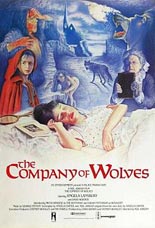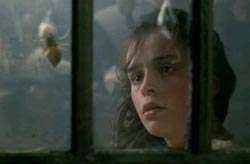
 Only Neil Jordan’s second feature, 1984’s The Company of Wolves can be viewed as Gothic testing ground for his eventual epic blockbuster in Interview with the Vampire one decade later. For all its here-and-there hiccups, however, I find Wolves to be the far superior film.
Only Neil Jordan’s second feature, 1984’s The Company of Wolves can be viewed as Gothic testing ground for his eventual epic blockbuster in Interview with the Vampire one decade later. For all its here-and-there hiccups, however, I find Wolves to be the far superior film.
Visually sumptuous and rich in detail, Wolves is a remarkable adaptation of Angela Carter’s dark fiction, written with Jordan by Carter herself. Almost all of it takes place within the feverish, fairy-tale dreamworld of young, blossoming Rosaleen (Sarah Patterson, 1987’s Snow White). In a sequence that’s one of the screen’s best-ever representation of nightmares, her older sister dies; to let her parents properly mourn, Rosaleen goes to stay with her grandmother (Angela Lansbury, The Manchurian Candidate), who shares some seriously macabre bedtime stories. Like Alice plummeting down Wonderland’s rabbit hole, the picture keeps drilling into deeper levels as Granny’s tales are depicted.
 In one story, a newlywed man (Stephen Rea, The Crying Game) skips consummation in order to answer the call of nature, only to reappear years later. In another, a spiteful witch (Dawn Archibald, Caravaggio) turns a wedding reception turned into a circus of Canis lupus proportions. Eventually, Rosaleen and Granny take part in a twisted update of Little Red Riding Hood.
In one story, a newlywed man (Stephen Rea, The Crying Game) skips consummation in order to answer the call of nature, only to reappear years later. In another, a spiteful witch (Dawn Archibald, Caravaggio) turns a wedding reception turned into a circus of Canis lupus proportions. Eventually, Rosaleen and Granny take part in a twisted update of Little Red Riding Hood.
Horror fantasy at its classiest, The Company of Wolves uses its once-upon-a-time canvas to explore budding sexuality, just as the Brothers Grimm did in their original, unexpurgated tales. The film’s purposeful artificiality, created by production designer Anton Furst (an Oscar winner for 1989’s Batman) is seductive in its own right, drawing the viewer into a surreal existence of the filmmakers’ imagining. The werewolf transformations are superb in their grotesque nature, and when Rosaleen’s real and unreal worlds collide at the end, the effect is chilling. The material works so well, it’s a shame more of Carter’s works weren’t brought to life, especially by Jordan. —Rod Lott

An overlooked gem.